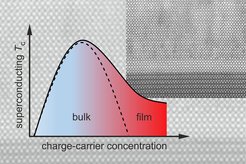Optical conductivity and superconductivity in highly overdoped La2‑xCaxCuO4 thin films
Thin-film technology enables synthesis of superconducting material that is unstable in bulk form
Chemical substitution is widely used to modify the charge carrier concentration ("doping") in complex quantum materials. A prominent example is the "214" family of high-temperature superconductors, La2-x(Ba,Ca,Sr)xCuO4, where substitution of the trivalent La ions by divalent alkaline-earth ions releases positive charge carriers that form the supercurrents at low temperature. However, the randomness and disorder associated with chemical substitution affects the electronic properties in a manner that remains difficult to describe in the framework of quantitative theories. In particular, it remains unknown if disorder is responsible for the experimentally observed disappearance of high-temperature superconductivity at high charge carrier concentrations (see the figure). Current research therefore aims to develop a microscopic understanding of these effects, and then to optimize the functionality of quantum materials through "disorder management".

In the case of the 214 superconductors, these efforts have been hampered by the chemical instability of bulk La2‑xCaxCuO4, where disorder is minimal because the sizes of the Ca2+ and La3+ ions are nearly equal. We have overcome this challenge by using a substrate with a similar lattice structure as a template for high-quality La2‑xCaxCuO4 films. Measurements of the optical conductivity as well as other physical properties were then used to characterize the charge carrier concentration in these films. We found that high-temperature superconductivity is stable up to much higher doping levels than previously found for analogous bulk compounds with higher levels of disorder. The results imply that doping-induced disorder is the leading cause of the degradation of superconductivity for large charge-carrier concentrations, and they open up a previously inaccessible regime of the phase diagram of high-temperature superconductors to experimental investigation.











